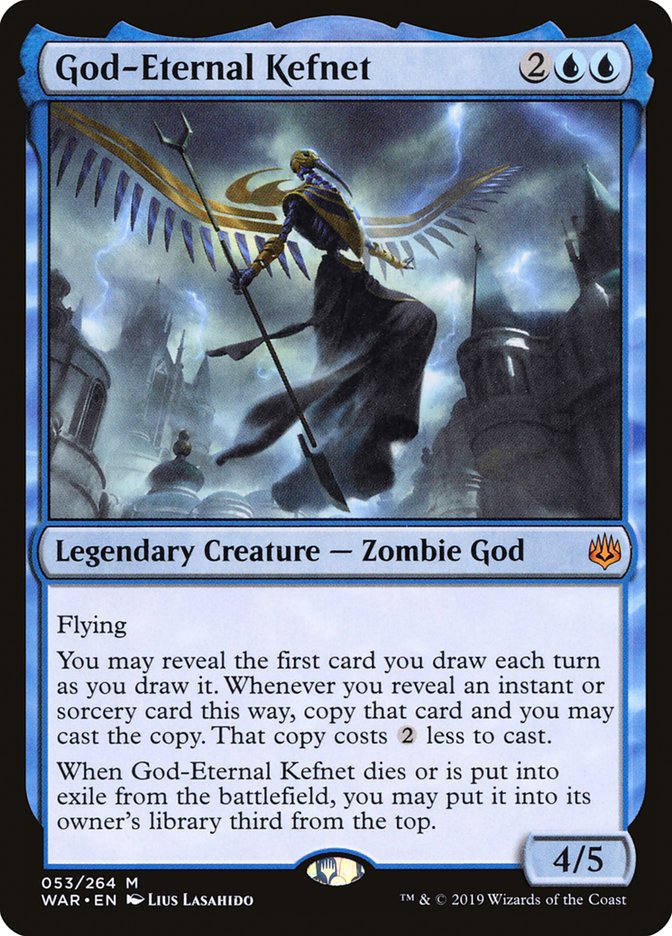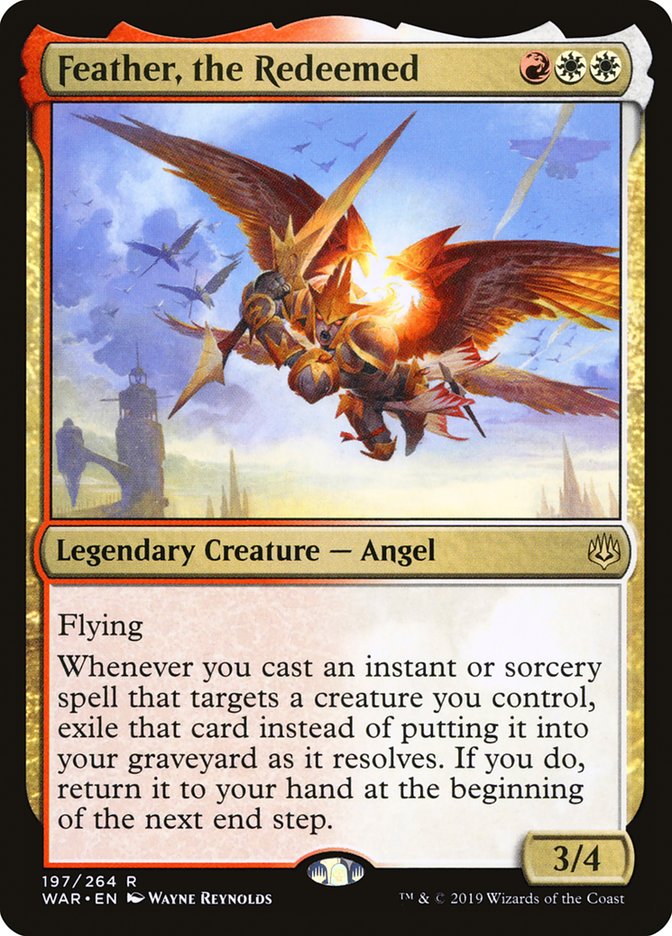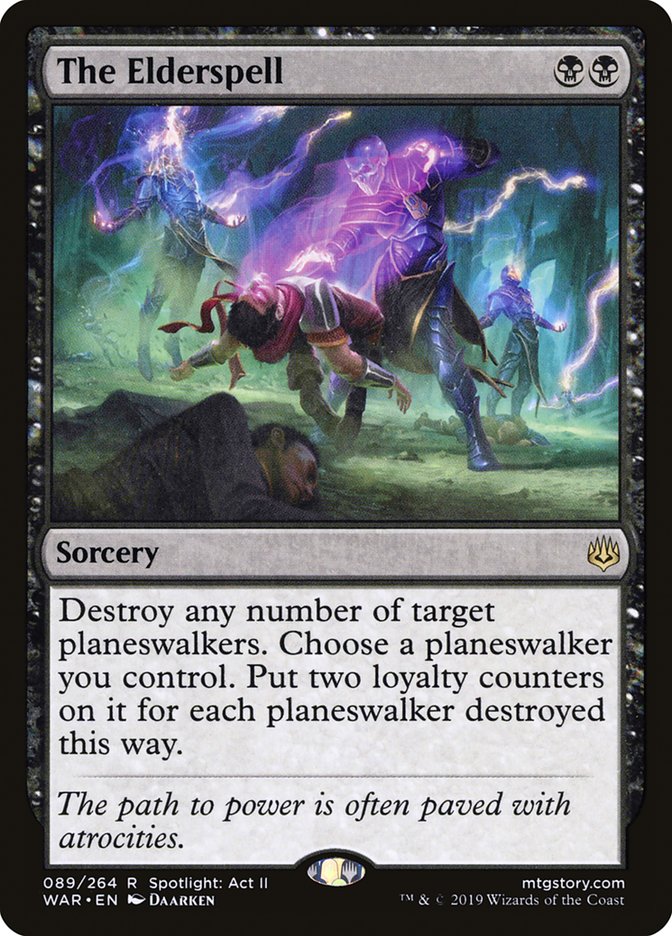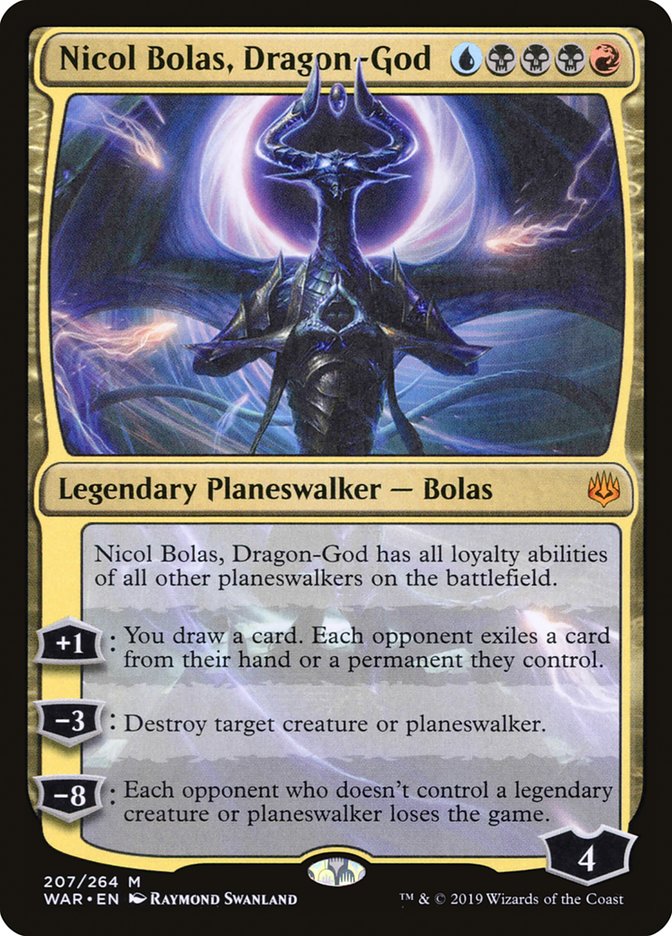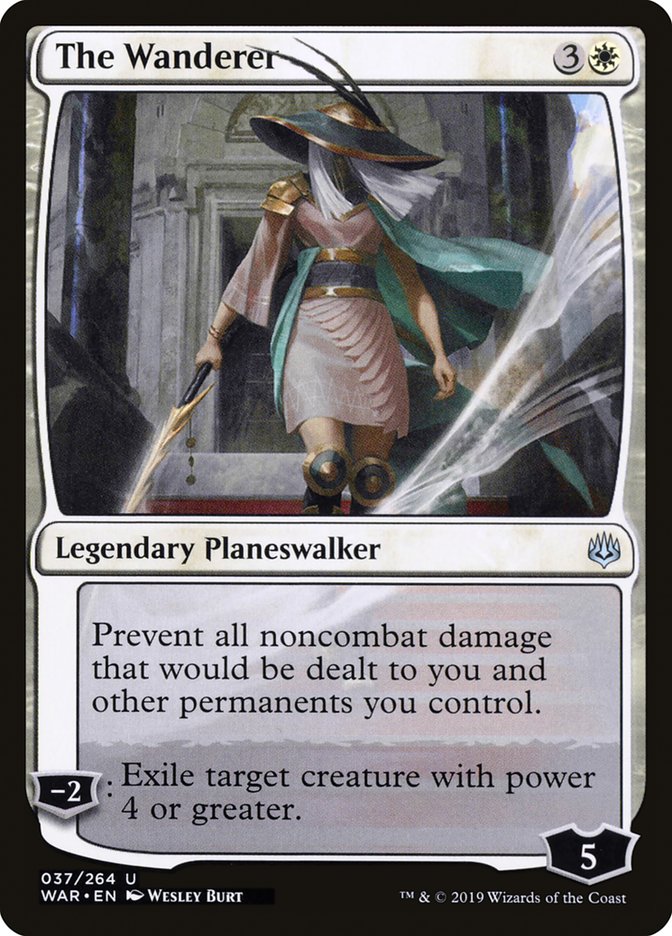Welcome to another edition of Fact or Fiction! Today, Sam Black, Ross Merriam, and Ari Lax are here to render their verdicts on five statements about War of the Spark preview season. Don’t forget to vote for the winner at the end!
1. God-Eternal Kefnet is the real deal and will change how control decks are built in War of the Spark Standard.
Sam Black: Fiction. There may be a successful Kefnet deck, but it won’t radically transform or define control the way that Teferi, Hero of Dominaria has. Having five toughness and being legendary does protect Kefnet from some common removal like Lava Coil and Cast Down, but Kefnet is still awful against Vivien Reid, which is a real problem for control.
The bigger problem is just the extent that you have to go out of your way to get the most out of Kefnet. Obviously you need a lot of instants and sorceries, but beyond that, control decks want to be reactive, and while Kefnet gives you a discount, it’s still asking you to take actions during your own turn and doesn’t work with counterspells.
Kefnet is at its best in a midrange Izzet deck with a lot of burn spells, and if that deck works out, I’m not the sort of person who would look at that as changing control decks as much as generating a new deck.
The basic Teferi-style control decks we’ve seen are likely still good and likely not interested in this card. Even in Izzet decks, I’m not sure this is better than Crackling Drake.
Ross Merriam: Fiction. The stats on Kefnet are solid, but certainly not world-changing, and the ability is far too hit-or-miss for my taste. It’s hard to build around a card when you can’t rely on it to do the same thing game after game, which means we have to view the most powerful part of the card as a bonus rather than anything else.
That realization leaves us with the idea of putting a medium-sized flyer in our control decks, which I’m not in for, especially in a format that includes Niv-Mizzet, Parun. We need to be leveraging the body on Kefnet more reliably than a control deck can.
The possibility for a midrange deck that includes Kefnet exists, but I’m still skeptical of a four-mana card that provides no immediate value and inconsistent value once you untap. The major plus here is that fifth point of toughness, which means Kefnet can rumble with Rekindling Phoenix and dodge Lava Coil. Since it also dodges Cast Down by virtue of its legendary status, that body is more likely to stick around and contribute to stabilizing the battlefield against aggressive decks or pressuring control decks.
Still, there are enough cards that remove it that I’m not too high on it. The protection ability doesn’t generate card advantage since it takes a draw step to get it out of your library and three turns later you’re in the same situation, casting a mopey flier and hoping you untap with it.
Ari Lax: Fact, but also Fiction. God-Eternal Kefnet is quite good, but I have doubts about it changing control decks or the immediate future of Standard.
God-Eternal Kefnet reminds me of two cards: Rekindling Phoenix and Keranos, God of Storms.
If you don’t remember playing with Keranos, it’s kinda clunky. I expect that the cool miracle trigger on Kefnet is less important than the abilities “fifth toughness” and flying. The trigger also doesn’t work with counterspells, and usually your spot removal doesn’t need a ton of duplicating to stabilize in a true control deck when you untap with your 4/5 flying creature.
Where I like God-Eternal Kefnet is in the exact midrange threat slot that Rekindling Phoenix fills. Hard to kill, good on defense and offense. The current issue is that Kefnet works best with flexibly proactive red spells, and Rekindling Phoenix does that exact job really well if you can cast those. It might end up being a great transitional threat in various Wilderness Reclamation sideboards to layer with Biogenic Ooze, but again, Temur still has access to Rekindling Phoenix.
God-Eternal Kefnet is very powerful. It has all the right stats and good abilities. But it’s also up against some insane competition, and I wouldn’t be surprised if it needs a rotation to get a few of those cards out of the way to really see play.
2. Feather, the Redeemed’s combo potential is legit and not just another flash in the pan.
Sam Black: Fiction. Feather will succeed or fail based on the strength of the archetype it enables. While there’s precedent with Azorius Heroic being a somewhat viable Standard deck and a lot of important cards have been pushed for the archetype in addition to Feather itself, like Tenth District Legionnaire and Dreadhorde Arcanist, even with the archetype getting access to fantastic removal in Reckless Rage, I still think it’s just too hard for an archetype to break through in Standard enabled almost entirely by a single set.
The deck has a chance, and it definitely has a lot of the right things going for it, but if you’re asking at even money whether I’d pick Feather, the Redeemed to appear in the Top 8 of a given Standard event a month from now, I’d have to guess that the safer money is on no.
Seriously, though, Ross’s take on Boros Heroic does look sweet, and it’d be cool if something like that is good. I’m just not optimistic about its ability to manage not getting run over by red decks or just having its creatures countered or destroyed by control decks and flooding with tricks. A playset of Sheltering Light is good, but it only takes you so far.
Ross Merriam: Fact. What a difference a mana makes. Feather, like Kefnet, is a medium-sized flier that needs you to untap in order to generate value, and this one even dies to Lava Coil. But the risk of it dying is significantly less at three mana than four, since you’ll have more time to recover and the tempo loss won’t ever be as significant.
But more importantly, it’s much easier to reliably take advantage of Feather’s ability than Kefnet’s, since it merely requires you have spells to target your creatures in hand, rather than draw them off the top of your deck.
With Defiant Strike, you draw extra cards cheaply. That kind of effect is important because it means you can take advantage of Feather’s ability to gain a material advantage even on an otherwise empty battlefield. With Samut’s Sprint, you have the threat of a large, haste flyer against planeswalkers. And there are several removal spells that will target your creatures, most notably Reckless Rage and Thrash.
I was skeptical of a Heroic-style deck in Standard given that the mechanic isn’t actually in the set, but I’ve been impressed by what I’ve seen from Feather and Tenth District Legionnaire on VS Live! and even explored the potential for the archetype in an article earlier this week.
Opens Gmail
To: Cedric Phillips
Subject: Urgent: Reply Requested
Is there a multiplier on my bonus if I plug two pieces of content in one sentence?
-Ross
End Scene
Ari Lax: Fiction. The definition of a combo usually involves breaking fundamental rules of Magic: chaining a bunch of card draws, breaking the constraints of mana and land drops, just winning the game regardless of resources.
What part of a delayed card advantage engine is a combo? I don’t know about you, but when I think of targeting my creatures and the word combo, there usually isn’t another end step. If I ever get my Temur Battle Rage back with Feather, the Redeemed, I made a mistake in deck construction.
I’m struggling to imagine the card I would consider a good combo with Feather, the Redeemed. Aurelia’s Fury locking someone out seems terrible, because that’s a Turn 4 setup and Modern isn’t about giving your opponents a Turn 4 to do stuff with. Thrash in Standard is about the closest I think it gets, and even then, for those two cards to see play, you have to be in a creature-dominated format where four toughness matters, but also not one where Azorius Aggro just laughs you out of the room for paying three mana for one creature.
3. The Elderspell is a perfectly designed answer to planeswalkers that the game has been waiting for.
Sam Black: Fiction. This card is kind of a mess. I mean, it’s cool and all, and it’s neat that you can build around casting it on your own things, but this is the kind of card that’s printed as a failsafe in case they went too far, rather than a normal tool for a format. It’s too narrow to see maindeck play, and while it looks amazing at what it does, really, it’s pretty hard to get even a two-for-one out of this card, unless we see far more planeswalkers in the coming months than we have in the past.
I think the right answers to planeswalkers are cards like Hero’s Downfall and Vraska’s Contempt. I don’t like that answers always cost a lot of mana, but if I have to pick the cards in this set that best address that, I’d say I really like Angrath’s Rampage and Spark Harvest.
I do think it’s a good idea to print radical answers in sets that push new things just in case they were pushed too far, like Creeping Corrosion, but those cards are never, “This is the exact right way to do this.” They are, “Let’s just make sure we’ve covered our bases and players have recourse if things get too out of hand.”
Ross Merriam: Fiction. Planeswalkers are difficult to remove. There aren’t as many spells that target them as there are those that target creatures or artifacts. Even more rare are spells that can answer multiple planeswalkers at once.
But one reason that removal for planeswalkers is rare is that planeswalkers are also rare. War of the Spark may be bringing them all together, but I’m still not expecting many Standard decks to play a ton of them. It’s important to have some outs to planeswalkers, especially in decks that can’t reliably attack them, but having those outs come at the expense of the versatility of your removal suite is a negative trade.
For every time you get to kill two planeswalkers or add a ton of relevant loyalty counters to your own planeswalkers, you’re going to stare at ten copies of Wildgrowth Walker, Goblin Chainwhirler, and Thief of Sanity, wishing you had a Cast Down.
There are some matchups where creatures aren’t plentiful, or planeswalkers are, in which this may be a suitable sideboard option, essentially any matchup that can diminish the percentage of time it’s irrelevant while retaining the high upside. And I like having narrow, but powerful sideboard cards like that. It’s good for Magic to have flashy effects be possible, but unlikely, so it feels special when the stars do align. But that is a far cry from being perfectly designed, and I don’t know who was eagerly waiting by their keyboards for a card like this, but it wasn’t me.
Ari Lax: Fiction. How many planeswalkers do decks usually play? If you look back at decks considered SuperFriends, it’s less than you think. The literal Azorius SuperFriends deck from Rise of the Eldrazi Standard played seven. You usually don’t see more than nine in a deck, with rare exceptions breaking the ten mark. Are you excited about Cast Down against Grixis Midrange, a deck with about that many creatures, or are you carefully balancing your removal count so you have a couple answers but never flood on them?
Also, remember how every battle of removal versus planeswalker tends to end. The player who lost Teferi, Hero of Dominaria to The Elderspell drew a card. If you hit multiple planeswalkers with this, one of those planeswalkers activated multiple times and its controller drew multiple cards. This is why Blightning was such a crucial part of managing some of the best planeswalkers ever. It cleared them out and covered all the advantage they accumulated.
There are definitely scenarios where The Elderspell is exactly what you need for a specific planeswalker setup or faceoff, but it’s a highly inflexible card that puts you behind on resources to trade off. The best answer to planeswalkers remains one that is card-neutral, also known as the combat step.
4. Nicol Bolas, Dragon God is the most powerful planeswalker previewed thus far in War of the Spark.
Sam Black: Fiction. Power is a tricky quality to define. Nicol Bolas is definitely a planeswalker with a great rate on impact per casting cost, but that’s kind of the floor when you cost RBBBU. That casting cost is hard enough to pull off in the Standard we’ve known, but it gets much worse when you realize how much you’re giving up by not playing any of the new colorless lands in War of the Spark. I think we’ll see a lot more two-color decks and fewer three-color decks and decks leaning so card on the CCC spells like Goblin Chainwhirler when players have the opportunity to play with cards like Blast Zone or Mobilized District if they can keep their mana requirements less greedy.
Liliana, Dreadhorde General is my pick for most powerful, both measuring for immediate impact and amount that I believe it will see play and success. The opportunity cost is just so much lower, and I think it’s a lot better at stabilizing on a wider variety of battlefields. Having the plus ability generate an actual battlefield presence in addition to card advantage is very important, and answering two creatures rather than just one with the minus ability can catch you up from further behind.
Ross Merriam: Fiction. Nicol Bolas, Dragon-God is good. I think it will see play. But once again the bar is high, and for me, the most powerful planeswalker previewed thus far is Teferi, Time Reveler.
Nicol Bolas follows the Ob Nixilis Reignited / Vivien Reid mode of five mana for card draw, removal, and an ultimate that wins the game. I don’t Foresee (sorry, I mean Tamiyo’s Epiphany) the static ability coming up often, since it’s likely best to simply off the opposing planeswalker with the -3, so it’s mostly a souped-up version of the kinds of planeswalkers we know are good, with a restrictive mana cost to compensate.
Teferi, Time Raveler is new, and it has no obvious point of comparison in Magic’s history. The -3 is a great bit of tempo, or card advantage when used on your own enters-the-battlefield creatures. But the real winner is that static ability, which shuts down control and Wilderness Reclamation decks. The ability for a midrange player to maindeck a card which gives them such a huge advantage against one side of the metagame is game-changing, since biasing to beat up the aggressive decks in Game 1 is easy, and a Teferi backed up with discard and countermagic in games two and three is plenty.
Add in the ability to cast your Thought Erasures, Time Wipes, and Enter the God-Eternals at instant speed on occasion and you have my pick for most important card in the set. There will be games where Teferi doesn’t do enough against an aggro deck or doesn’t stick early enough against the control decks, but the percentages shift significantly, and Magic is a game of small edges.
Teferi makes it much easier to avoid the midrange problem of drawing the wrong half of your deck and doesn’t sacrifice on the everyday metrics of gaining tempo and card advantage when compared to other three-mana planeswalkers. Casting it and using the -3 leaves you up a card, up the mana of whatever you targeted, and facing a battlefield where you don’t have to worry about counterspells, combat tricks, or Wilderness Reclamation shenanigans. And that’s without any help.
I’ve been impressed by a couple of other planeswalkers in the set, Liliana, Dreadhorde General and Vivien, Champion of the Wilds in particular, and a new Gideon still hasn’t been previewed, but I’m in on Teferi for now.
Ari Lax: Fact. This is true just off the +1 and -3 abilities. “+1 draw a card, -3 kill a thing” has been universally good enough for Standard play on a planeswalker. Nicol Bolas, Dragon-God is a good version of that.
I’m not even interested in the static ability. If they control a planeswalker and I don’t just want to -3 Nicol Bolas, Dragon-God on it, I don’t get it. If I control two planeswalkers, do I need them to be a super-duper combo or is my opponent just dead? The ultimate is also kinda win-more. Think about how a Vivien Reid emblem negates any counterplay they have besides literally killing Vivien, while Nicol Bolas lets them just cast a planeswalker to dodge death and force a big -3.
The +1 on Nicol Bolas puts you up two pieces of cardboard. How are you supposed to compare the other similar planeswalkers to that? The -3 on Bolas does the same thing as Teferi, Hero of Dominaria and bricks opposing planeswalkers as valid threats against control decks. How many times have you seen an Esper Control deck not care that the follow-up to a Kaya’s Wrath is Vivien Reid because that just means Teferi lands on a clean battlefield at one loyalty? Nicol Bolas, Dragon-God does the same thing for Grixis.
5. The Wanderer is Emrakul in disguise.
Sam Black: Fiction. As I understand this theory, it’s predicated in part on stylistic similarities between The Wanderer and Emeria as depicted on Shrine of the Forsaken Gods. Personally, I’m not seeing much in common. Emeria has wings and Emrakul-like tentacles behind her, holds two weapons, wears a hood instead of a hat – really, the only similarity I’m seeing is that they both wear shoulder pads.
Okay, so I guess the case it less precise than that, maybe it’s just that there’s precedent for Emrakul being represented as a white-aligned humanoid, but why these abilities? Also, I don’t think Emeria was ever a benevolent being. I think the point is that the story was cleaned up and cheerful versions were told and somehow this ancient horror was slowly reinterpreted as a benevolent deity over generations – here we’re seeing the character in the moment, and I don’t know how or why Emrakul, who I don’t take to have any understanding of human morality, would be or pose as a benevolent figure. Elspeth seem far more likely, especially given the mechanical similarity in answering creatures with four or more power.
Ross Merriam: Tails. Seriously, I flipped a coin and it came up tails. Look:

Of course, after I flipped it I realized I had forgotten to assign which side of the coin would be fact. But I honestly didn’t care enough to flip again.
If you’re into the lore behind Magic, then cool. But it’s not for me. Never has been. So I just stay out of it.
As far as I’m concerned, “The Wanderer” is a song by Dion about a man with deep commitment issues. It’s also a worse song than both “I Wonder Why” and “Runaround Sue.”
Does Emrakul have commitment issues? Given that her latest iteration was named “The Promised End,” I’m going with no. That’s as far as I’m willing to take the metaphor.
Ari Lax: Fiction. That’s some Harry Potter fanfic-level trash right there.
If you think you want this to happen, I’m giving you homework. Read The Promised End and come up with five better ways to introduce Emrakul’s presence into the Bolas storyline. Just off the top of my head, I have “Emrakul planted seeds in Nissa’s mind to allow her to prevail in this situation at the cost of her sanity,” “Liliana using her fight against Emrakul as a keystone in coming to terms with annihilation and succumbing to The Chain Veil to fight Bolas,” and “anything with Ugin.”


